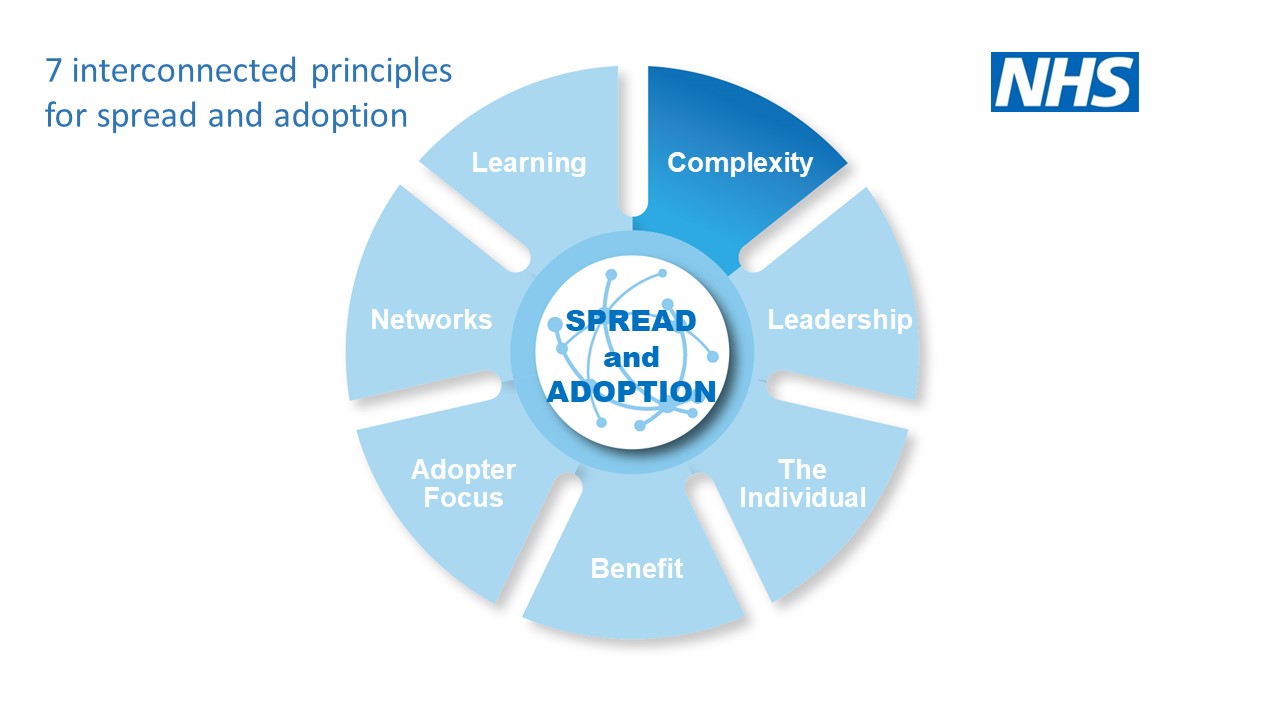The recently launched Guide, Leading the Spread and Adoption of Innovation and Improvement: A Practical Guide, offers seven interconnected principles. This blog is the first in a series of blogs, each focusing on one of the seven principles.
These principles represent important aspects to consider for spread and adoption and are explained in the Guide. All seven principles are important, they are interconnected and each will have a different importance and require different actions in different settings. Relational, interpersonal elements of spread and adoption – looking at how people can work together – is a common thread within each of the principles.
Complexity is one of the seven interconnected principles in the Guide. Enabling the spread and adoption of innovation and improvement in health and care is an increasingly complex activity so understanding complexity and the implications for our work is important.

Enabling spread and adoption of innovation and improvement in our complex, inter-dependent world is difficult. Health and care is a complex adaptive system, continually changing and adapting, which means:
- we cannot completely understand it simply by knowing about the individual components
- we can’t assume an innovation or improvement that has worked in one local system will spread and work in another place, because different local systems have different needs and interdependencies and the overall system is always evolving
- the need to work with high levels of interdependence and connectivity, competing and changing demands, unpredictability, uncertainty, myriad relationships – as well as emergence
What is complexity?
It is important to understand if you are working with complexity so you can match your approach to your individual situation, increasing the likelihood of success. Spreading an innovation may include aspects that are simple, complicated, and complex. It is important to know the difference.

Complex – a complex situation is when you can’t predict with certainty the result of actions, there is no cause and effect, the same actions may produce a different effect each time. Complexity is characterised by unpredictability and interconnectivity, the need for flexibility and adaptation and is underpinned by relationships. The result for leaders and staff is the need to be able to work with constant change and emergence and the challenges such a system produces. Experience helps but doesn't predict outcome.
A complex situation is not a higher order level of a complicated one but a very different situation. A workplace example is working with many people and organisations crossing organisational and professional boundaries on issues that keep changing. At home an example is raising a child.
Complicated – a complicated situation requires experience and may involve many people and steps but there is predictability and certainty that if the steps are followed the desired result will be achieved. There is a cause and effect relationship. The actions can be repeated at another time with success.
A workplace example is a new item directly replacing an old item used by a specific number of people for a specific reason. Sending a rocket to the moon is an example of a complicated task.
Three aspects to consider
Complexity can exist in the innovation, the context, and the approach taken to spread and adoption. So in considering complexity and your spread and adoption plans you need to reflect on these three aspects of: context, innovation and approach.
Many innovations are complicated or complex, so their spread and adoption in our health and care context is not a simple predictable, process.
What do complexity and the principles mean in practice?
Increasing complexity produces a greater number of boundaries to be bridged in order to connect and collaborate. Create an adaptive space to enable connections and relationship development, emergence, adaptation, flow of information and for managing the tension between an innovation and the operational system. An adaptive space is a temporary safe [virtual] space at the interface of normal business and the innovation where through developing relationships, addressing tensions, shared learning and working with emergence spread and adoption can be enabled.
An enabling leadership style is needed and will be the focus of the next blog.
The blog Understanding and Working with Complexity gives more detail on complexity and how to work with it.
Use the Guide to help plan your spread and adoption work and to match your approach to your own context. More detail on the complexity principle and applying it in practice in the Guide here.
These seven interconnected principles can be used by individuals, or by a team, and at all levels; local, regional and national and settings where the spread and adoption of complex change is needed. These principles can be used to inform planning and to inform ongoing reviews. This blog Introduction to the Seven Interconnected Principles for Spread and Adoption offers an overview of all seven principles.
Details of how these principles apply to the work we do are described in How the Seven Spread and Adoption Principles Work in Practice: the Continuing Healthcare Improvement Collaborative case study.

Photo by Pawel Czerwinski on Unsplash
More information on the seven spread and adoption principles and system convening is available on the NHS Horizons website including blogs on complexity:
- Understanding and Working with Complexity
- COVID-19 – A Complexity Leadership Response
- Spread and Complexity in the NHS
- Complex systems, networks and adaptive spaces
If you're interested to read more there are previous blogs and further blogs to follow. Please do subscribe to this blog and follow @DianeKetley @HorizonsNHS, #nhsspread.
We would love to hear your feedback about the guide, and how you will use it. Send a tweet to @DianeKetley @HorizonsNHS #nhsspread. If you prefer email, get in touch at England.si-horizons@nhs.net.



/Passle/5a5c5fb12a1ea2042466f05f/MediaLibrary/Images/6168334917af5b10f4bf1d30/2022-04-14-15-27-52-040-62583d78f636e9115805b2d5.png)
/Passle/5a5c5fb12a1ea2042466f05f/MediaLibrary/Images/6168334917af5b10f4bf1d30/2022-08-05-09-59-36-465-62ecea08f636e906acfed639.jpg)
/Passle/5a5c5fb12a1ea2042466f05f/MediaLibrary/Images/6168334917af5b10f4bf1d30/2022-07-28-14-57-17-405-62e2a3cdf636e9180c9835cb.png)
/Passle/5a5c5fb12a1ea2042466f05f/MediaLibrary/Images/6168334917af5b10f4bf1d30/2022-07-20-10-16-56-533-62d7d618f636ea07987f6668.png)
/Passle/5a5c5fb12a1ea2042466f05f/MediaLibrary/Images/6168334917af5b10f4bf1d30/2022-07-15-09-55-32-858-62d13994f636ea1398e71aa9.jpg)